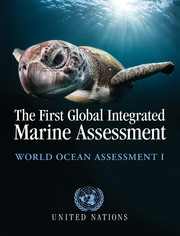Book contents
- Frontmatter
- Dedication
- Epigraph
- Contents
- Foreword and Preface
- Preface
- Summary of the first global integrated marine assessment
- The context of the assessment
- Chapter 1 Introduction – Planet, oceans and life
- Chapter 2 Mandate, information sources and method of work
- Assessment of Major Ecosystem Services from the Marine Environment (Other than Provisioning Services)
- Assessment of the Cross-cutting Issues: Food Security and Food Safety
- Assessment of Other Human Activities and the Marine Environment
- Assessment of Marine Biological Diversity and Habitats
- Section A Overview of Marine Biological Diversity
- Chapter 36 Overview of Marine Biological Diversity
- Section B Marine Ecosystems, Species and Habitats Scientifically Identified as Threatened, Declining or Otherwise in need of Special Attention or Protection
- I Marine Species
- II Marine Ecosystems and Habitats
- Section C Environmental, economic and/or social aspects of the conservation of marine species and habitats and capacity-building needs
- Overall Assessment
- Annexes
- References
Chapter 1 - Introduction – Planet, oceans and life
from The context of the assessment
Published online by Cambridge University Press: 18 May 2017
- Frontmatter
- Dedication
- Epigraph
- Contents
- Foreword and Preface
- Preface
- Summary of the first global integrated marine assessment
- The context of the assessment
- Chapter 1 Introduction – Planet, oceans and life
- Chapter 2 Mandate, information sources and method of work
- Assessment of Major Ecosystem Services from the Marine Environment (Other than Provisioning Services)
- Assessment of the Cross-cutting Issues: Food Security and Food Safety
- Assessment of Other Human Activities and the Marine Environment
- Assessment of Marine Biological Diversity and Habitats
- Section A Overview of Marine Biological Diversity
- Chapter 36 Overview of Marine Biological Diversity
- Section B Marine Ecosystems, Species and Habitats Scientifically Identified as Threatened, Declining or Otherwise in need of Special Attention or Protection
- I Marine Species
- II Marine Ecosystems and Habitats
- Section C Environmental, economic and/or social aspects of the conservation of marine species and habitats and capacity-building needs
- Overall Assessment
- Annexes
- References
Summary
Why the ocean matters
Consider how dependent upon the ocean we are. The ocean is vast – it covers seven-tenths of the planet. On average, it is about 4,000 metres deep. It contains 1.3 billion cubic kilometres of water (97 per cent of all water on Earth). But there are now about seven billion people on Earth. So we each have just one-fifth of a cubic kilometre of ocean to provide us with all the services that we get from the ocean. That small, onefifth of a cubic kilometre share produces half of the oxygen each of us breathes, all of the sea fish and other seafood that each of us eats. It is the ultimate source of all the freshwater that each of us will drink in our lifetimes. The ocean is a highway for ships that carry across the globe the exports and imports that we produce and consume. It contains the oil and gas deposits and minerals on and beneath the seafloor that we increasingly need to use. The submarine cables across the ocean floor carry 90 per cent of the electronic traffic on which our communications rely. Our energy supply will increasingly rely on wind, wave and tide power from the ocean. Large numbers of us take our holidays by the sea. That one-fifth of a cubic kilometre will also suffer from the share of the sewage, garbage, spilled oil and industrial waste which we produce and which is put into the ocean every day. Demands on the ocean continue to rise: by the year 2050 it is estimated that there will be 10 billion people on Earth. So our share (or our children's share) of the ocean will have shrunk to one-eighth of a cubic kilometre. That reduced share will still have to provide each of us with sufficient amounts of oxygen, food and water, while still receiving the pollution and waste for which we are all responsible.
The ocean is also home to a rich diversity of plants and animals of all sizes – from the largest animals on the planet (the blue whales) to plankton that can only be seen with powerful microscopes.
- Type
- Chapter
- Information
- The First Global Integrated Marine AssessmentWorld Ocean Assessment I, pp. 47 - 56Publisher: Cambridge University PressPrint publication year: 2017

